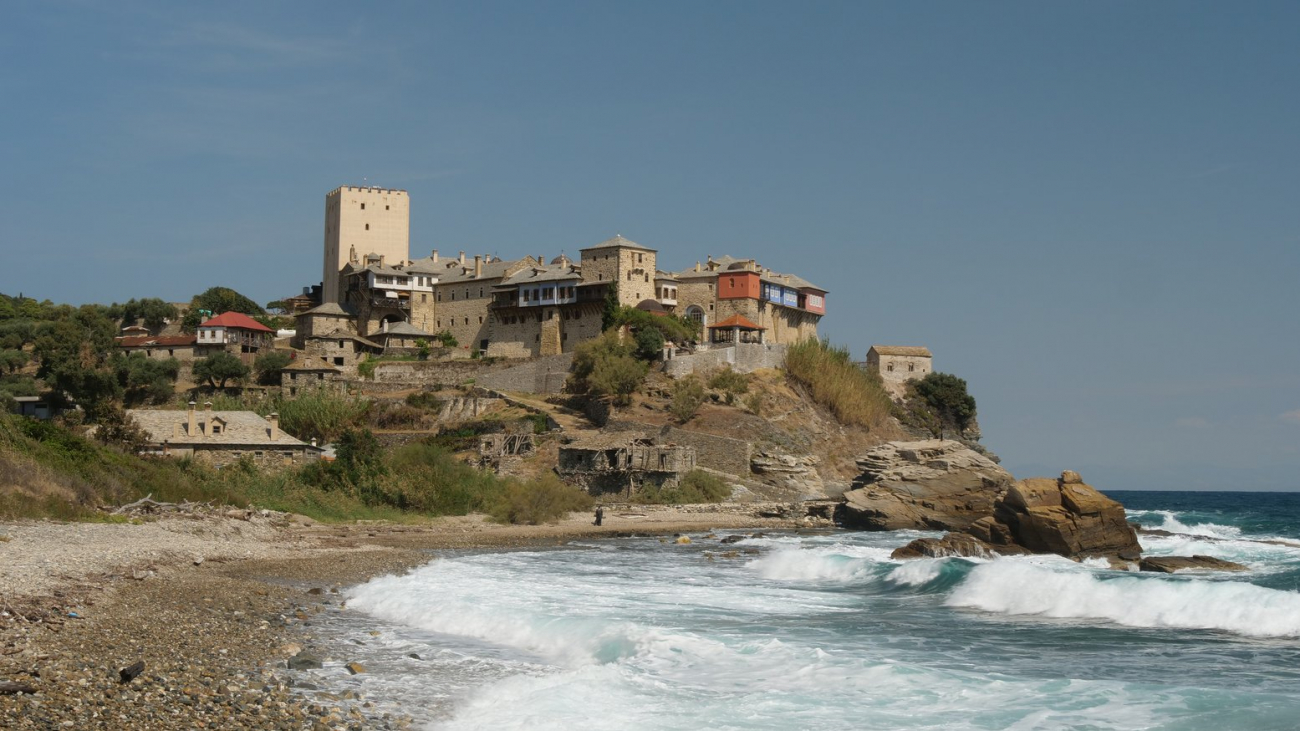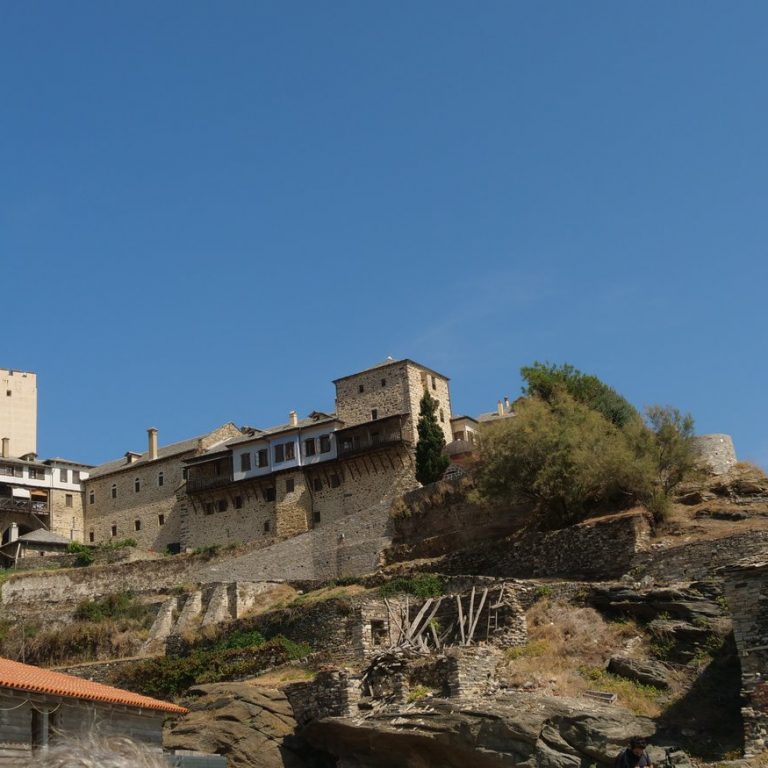Atop The Cliff
The Pantokratoros Monastery is the ecumenical administrative seat of the Orthodox Church and the most important of the Agios Oros monasteries. It is built upon a rocky overhang at the end of a wooded slope, at a height of about 30 meters above the sea, on the northeastern side of the Agios Oros peninsula. This location offers excellent views of the islands of Thasos, Limnos, Samothrace, and sometimes Imbros (weather permitting), as well as towards the northeastern shores of Agios Oros and the iconic Mt Athos, with its steep-sided summit.
Over the years, the location of the Monastery has been singled out by both Greek and foreign writers and travellers. The 17th century scholar and bishop Ioannis Komninos notes in his 1701 work The Pilgrim's Book (Proskynytirion) that 'the sacred and venerated Pantokratoros Monastery is exceptionally beautiful because of its advantageous position facing the sea, surrounded by the solid [walls of a] castle', while Kosmas Blachos (a respected deacon who lived in the 18th century) describes the Monastery as being 'situated on the eastern shore of the mountain, with its northeastern side supported by a cliff, and looking out on a broad horizon, while the waves thrashing against the cliff base create a wild and enjoyable spectacle'.
On the south side of the rocky ledge over which the Monastery dominates, a small harbor has been built, one of the two sheltered areas of Agios Oros which in the past were used to protect small boats in the event of storms. Apart from access by sea, today the Monastery can be reached by a road which starts from the town of Karyes, and branches off from the road leading to the Iviron Monastery. Footpaths also connect some of the monasteries, such as the path from the Vatopedi Monastery heading northeast, and the path between the monasteries Stavronikita ('The Conqueror of the Cross') and Iviron. A stone-paved road connects the Monastery with its affiliated Skete , the monastic community of the Prophet Elias, via an impressive route.
In early Byzantine written documents, the Monastery is referred to as the 'the divine seminary of Christ, the Almighty Saviour', and later as the 'central and patriarchal monastery of our Lord God and Saviour Jesus Christ the Almighty', titles reminiscent of the earlier, similarly named and well-known Byzantine Pantokratoros Monastery in Konstantinople, where the most influential monks of that period lived and worked.
Today the Monastery ranks seventh in the sovereign hierarchy of the Athonite monasteries, after the Koutloumousios Monastery and before the Xeropotamos Monastery.
Over the years, the location of the Monastery has been singled out by both Greek and foreign writers and travellers. The 17th century scholar and bishop Ioannis Komninos notes in his 1701 work The Pilgrim's Book (Proskynytirion) that 'the sacred and venerated Pantokratoros Monastery is exceptionally beautiful because of its advantageous position facing the sea, surrounded by the solid [walls of a] castle', while Kosmas Blachos (a respected deacon who lived in the 18th century) describes the Monastery as being 'situated on the eastern shore of the mountain, with its northeastern side supported by a cliff, and looking out on a broad horizon, while the waves thrashing against the cliff base create a wild and enjoyable spectacle'.
On the south side of the rocky ledge over which the Monastery dominates, a small harbor has been built, one of the two sheltered areas of Agios Oros which in the past were used to protect small boats in the event of storms. Apart from access by sea, today the Monastery can be reached by a road which starts from the town of Karyes, and branches off from the road leading to the Iviron Monastery. Footpaths also connect some of the monasteries, such as the path from the Vatopedi Monastery heading northeast, and the path between the monasteries Stavronikita ('The Conqueror of the Cross') and Iviron. A stone-paved road connects the Monastery with its affiliated Skete , the monastic community of the Prophet Elias, via an impressive route.
In early Byzantine written documents, the Monastery is referred to as the 'the divine seminary of Christ, the Almighty Saviour', and later as the 'central and patriarchal monastery of our Lord God and Saviour Jesus Christ the Almighty', titles reminiscent of the earlier, similarly named and well-known Byzantine Pantokratoros Monastery in Konstantinople, where the most influential monks of that period lived and worked.
Today the Monastery ranks seventh in the sovereign hierarchy of the Athonite monasteries, after the Koutloumousios Monastery and before the Xeropotamos Monastery.


